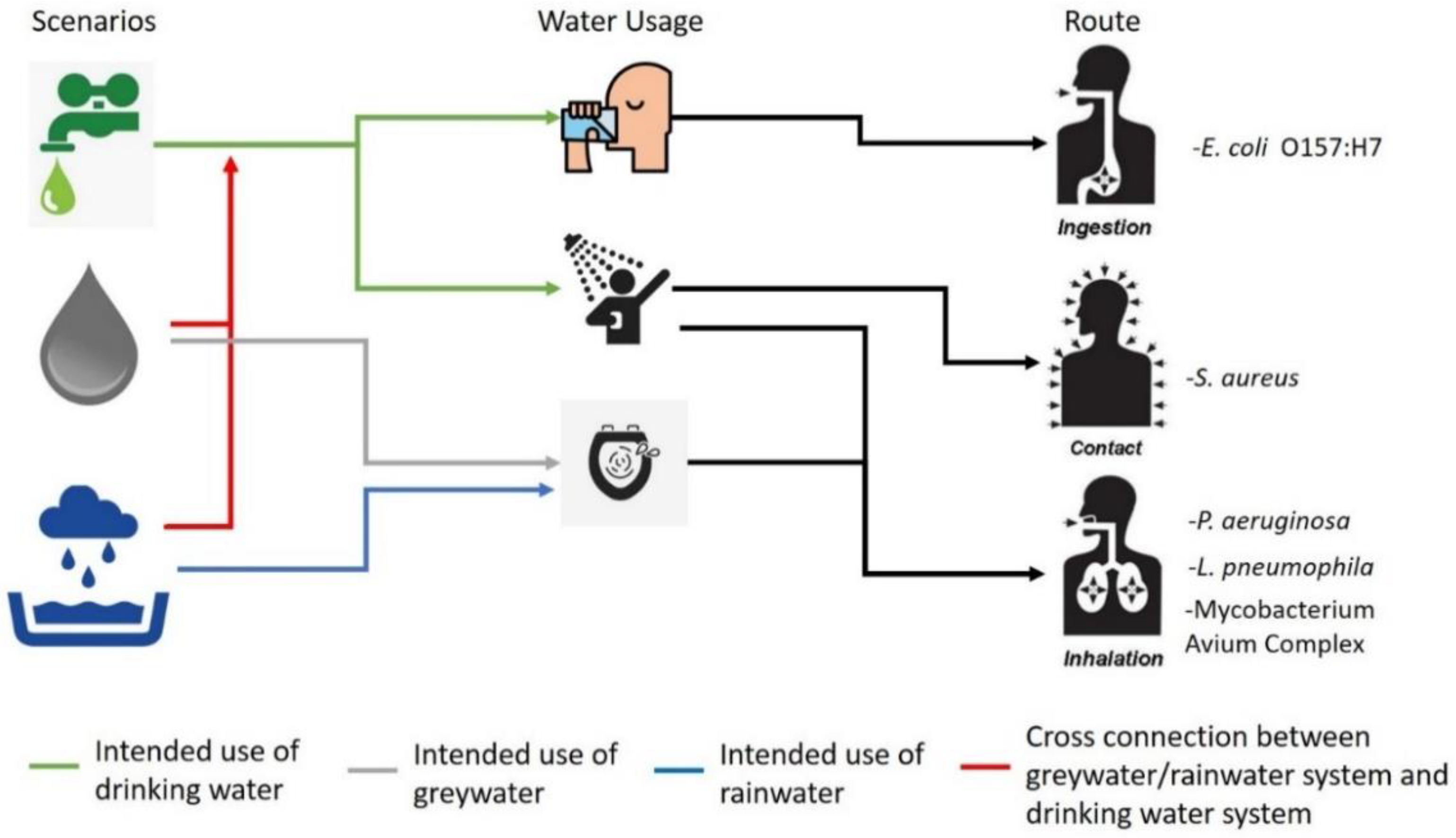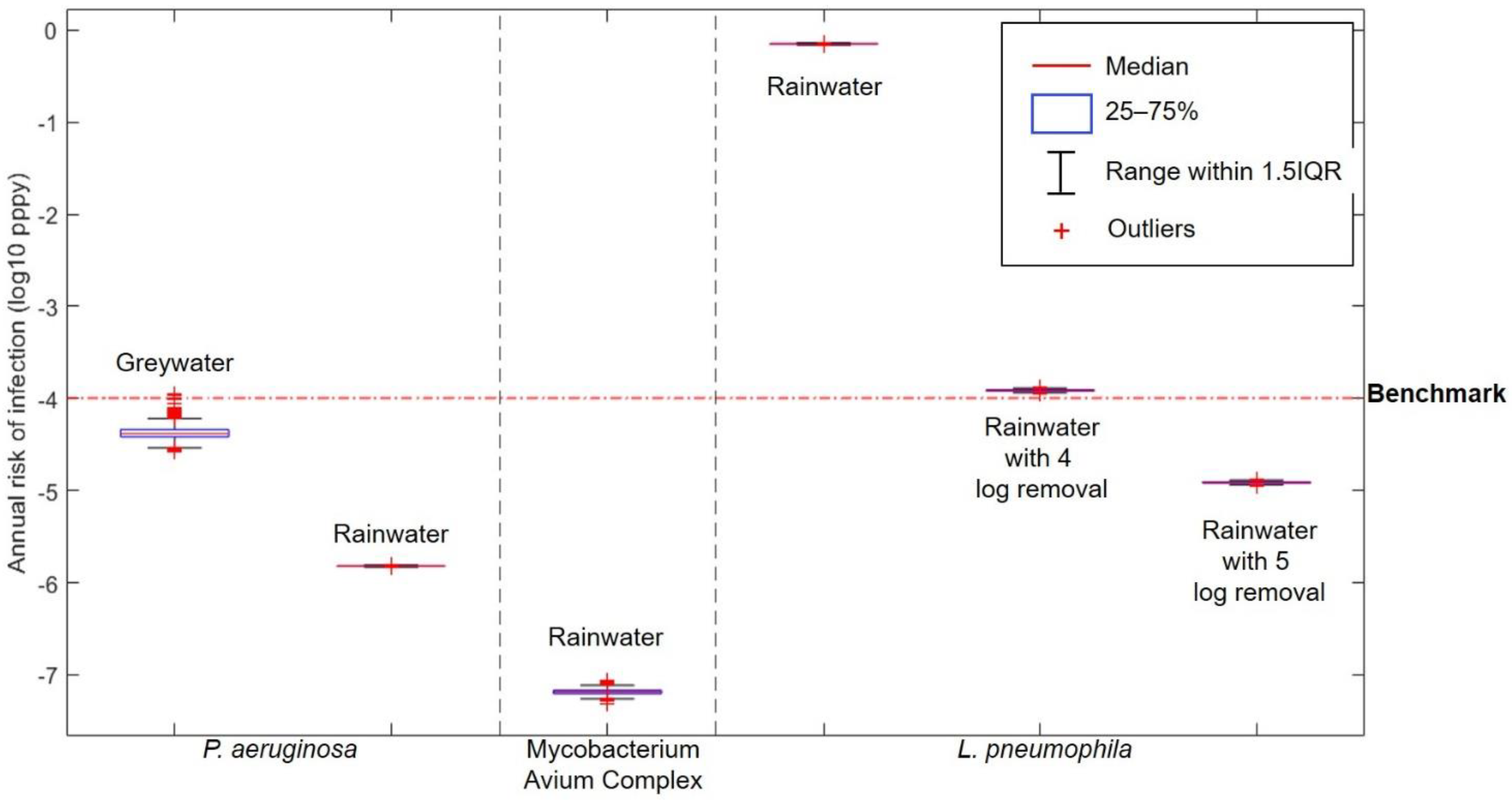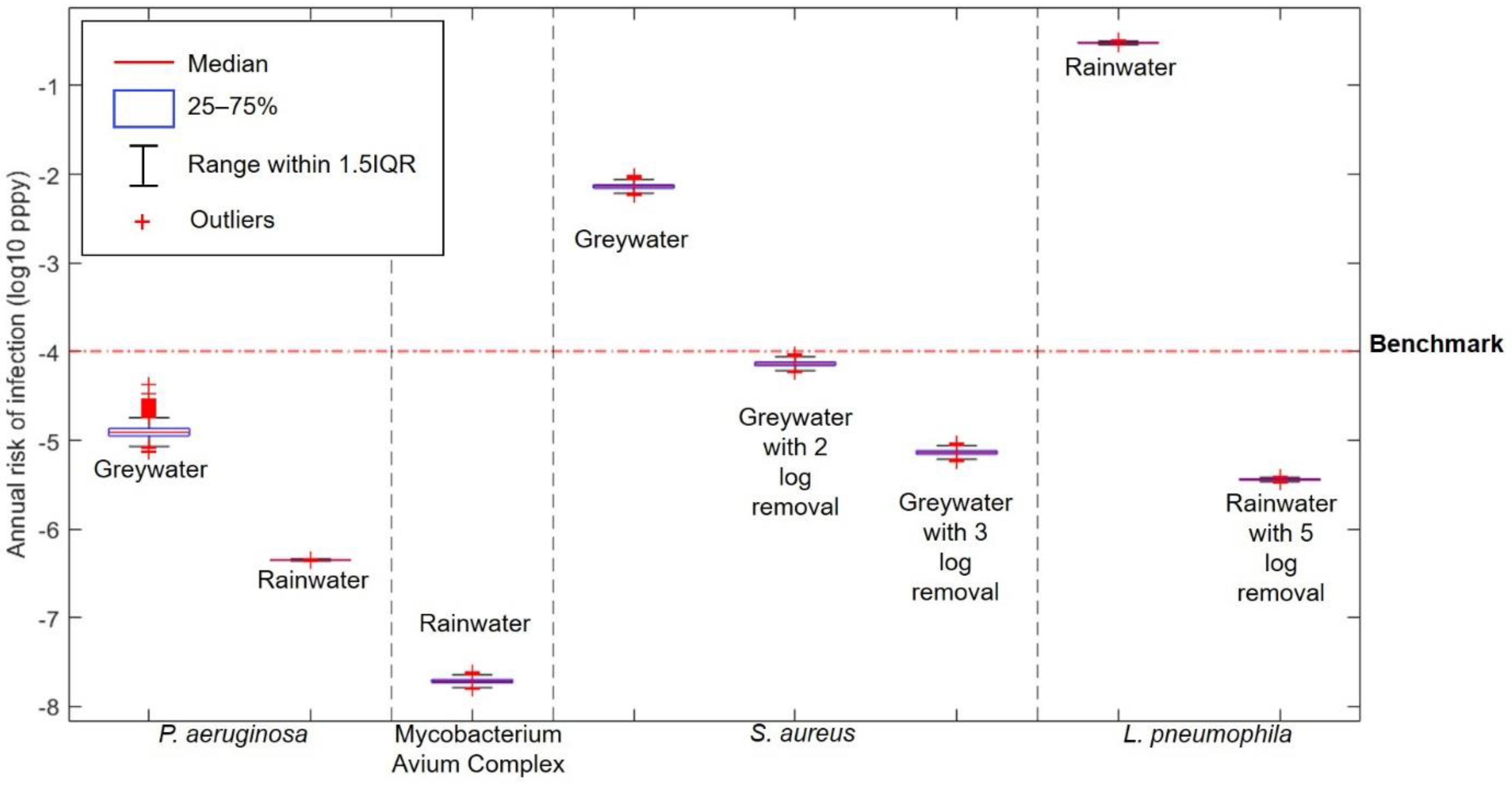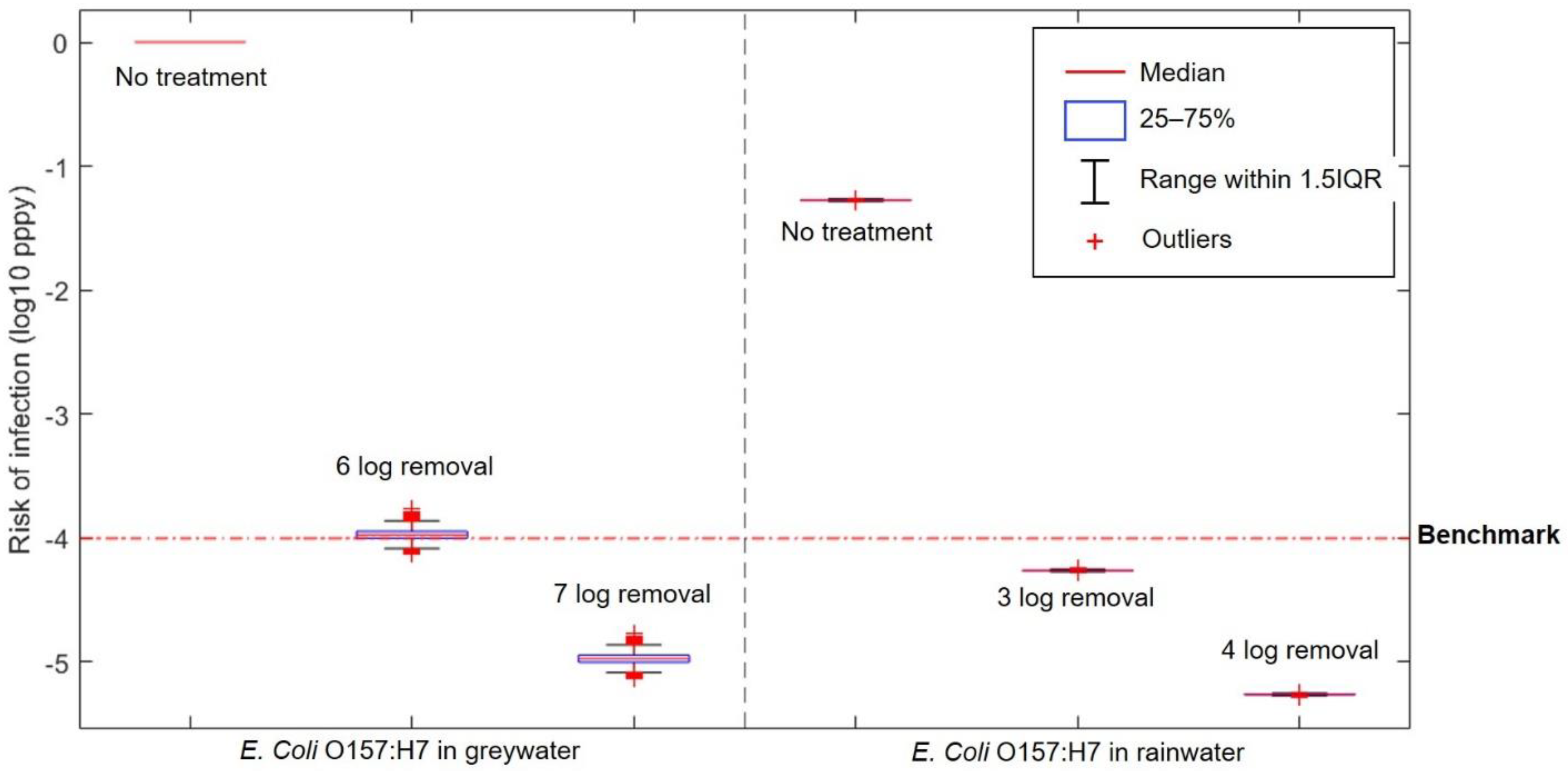Microbiological Health Risk Assessment of Water Conservation Strategies: A Case Study in Amsterdam
Abstract
1. Introduction
2. Materials and Methods
2.1. QMRA Method
2.2. Hazard Identification
2.2.1. Description of Scenarios
2.2.2. Target Pathogens in Greywater
2.2.3. Target Pathogens in Rainwater
2.3. Exposure Assessment
2.3.1. Concentration of Pathogens
2.3.2. Exposure Routes
2.3.3. Exposure Dose
- Ingestion route
- D = daily dose unit (CFU)
- C = concentration of pathogens in water (CFU/L)
- Vin = volume of ingested water per exposure event (L)
- N = number of events per day
- b.
- Inhalation route
- D = daily dose (CFU)
- C = concentration of pathogens in water (CFU/L)
- PC = partitioning coefficient (L/m3)
- IR = inhalation rate (m3/minutes)
- T = duration of exposure event (minutes)
- FRA = fraction of respirable aerosol
- RR = retention rate
- N = number of events per day
- c.
- Dermal contact route
- D = daily dose (CFU)
- C = concentration of pathogens in water (CFU/mL)
- h = thickness of water on skin after showering (cm)
- BSA = Body surface area (cm2)
- N = number of events per day
- Calculating for log removal
- DLR = daily dose after certain log removal (CFU)
- D = daily dose (CFU)
- LR = Log removal
2.4. Dose–Response
- Exponential model
- Pinfection = probability of infection
- k = probability of survival and reaching the host of the pathogen
- d = dose (CFU)
- b.
- Beta-poisson model
- Pinfection = probability of infection
- α = variable α
- N50 = the dose level at which 50% of the population is expected to be affected
- d = dose (CFU)
2.5. Risk Characterisation
- Pinf,ann = annual probability of infection
- Pinf,daily = daily probability of infection
- f = frequency
3. Results and Discussion
3.1. Risk Characterisation
3.1.1. Toilet Flushing
3.1.2. Cross Connection—Showering
3.1.3. Cross Connection—Drinking Water Consumption
3.2. Uncertainty of Pathogens Concentrations
3.3. Risk Mitigation Measures
3.3.1. Greywater Reuse
3.3.2. Rainwater Harvesting
3.3.3. Treatment Options
3.3.4. Cross Connection
3.3.5. Toilet Flushing
4. Conclusions
- Inhalation of aerosols from toilet flushing is the main exposure route to pathogens, with Legionella pneumophila as the major pathogen that causes high level of infection risk.
- The risk of infection from P. aeruginosa in untreated greywater for toilet flushing is below the benchmark of 10−4 pppy. However, treatment of greywater is recommended due to the ability of P. aeruginosa to regrow in reuse systems, even after disinfection. Harvested rainwater can also be used for toilet flushing after sufficient treatment through 5-log removal of L. pneumophila is done.
- Cross connections between drinking water and greywater/harvested rainwater systems pose a high daily risk of infection from E. coli O157:H7 through drinking and a high annual risk of infection from Staphylococcus aureus and Legionella pneumophila through showering.
- To mitigate the microbial risks, several measures can be implemented. The simplest measure is keeping the toilet lid closed during and after flushing. Collection and storage of greywater and rainwater should be managed well to prevent excessive growth of pathogens in the storage system. Cross-connections can be avoided through rigorous plumbing installation and test procedures.
Author Contributions
Funding
Institutional Review Board Statement
Informed Consent Statement
Data Availability Statement
Conflicts of Interest
References
- Mehta, C.M.; Khunjar, W.O.; Nguyen, V.; Tait, S.; Batstone, D.J. Technologies to Recover Nutrients from Waste Streams: A Critical Review. Crit. Rev. Environ. Sci. Technol. 2015, 45, 385–427. [Google Scholar] [CrossRef]
- Boretti, A.; Rosa, L. Reassessing the projections of the World Water Development Report. NPJ Clean Water 2019, 2, 1–6. [Google Scholar] [CrossRef]
- Qiu, J.; Shen, Z.; Leng, G.; Xie, H.; Hou, X.; Wei, G. Impacts of climate change on watershed systems and potential adaptation through BMPs in a drinking water source area. J. Hydrol. 2019, 573, 123–135. [Google Scholar] [CrossRef]
- Rickert, B.; Berg, H.V.D.; Bekure, K.; Girma, S.; Husman, A.M.D.R. Including aspects of climate change into water safety planning: Literature review of global experience and case studies from Ethiopian urban supplies. Int. J. Hyg. Environ. Health 2019, 222, 744–755. [Google Scholar] [CrossRef] [PubMed]
- Sjerps, R.M.; Ter Laak, T.L.; Zwolsman, G.J. Projected impact of climate change and chemical emissions on the water quality of the European rivers Rhine and Meuse: A drinking water perspective. Sci. Total. Environ. 2017, 601–602, 1682–1694. [Google Scholar] [CrossRef] [PubMed]
- van der Hoek, J.P.; de Fooij, H.; Struker, A. Wastewater as a resource: Strategies to recover resources from Amsterdam’s wastewater. Resour. Conserv. Recycl. 2016, 113, 53–64. [Google Scholar] [CrossRef]
- Song, X.; Luo, W.; Hai, F.I.; Price, W.E.; Guo, W.; Ngo, H.H.; Nghiem, L.D. Resource recovery from wastewater by anaerobic membrane bioreactors: Opportunities and challenges. Bioresour. Technol. 2018, 270, 669–677. [Google Scholar] [CrossRef] [PubMed]
- Bailey, O.; Zlatanovic, L.; Van Der Hoek, J.P.; Kapelan, Z.; Blokker, M.; Arnot, T.; Hofman, J. A stochastic model to predict flow, nutrient and temperature changes in a sewer under water conservation scenarios. Water 2020, 12, 1187. [Google Scholar] [CrossRef]
- Mourad, K.A.; Berndtsson, J.C.; Berndtsson, R. Potential fresh water saving using greywater in toilet flushing in Syria. J. Environ. Manag. 2011, 92, 2447–2453. [Google Scholar] [CrossRef]
- Semaan, M.; Day, S.D.; Garvin, M.; Ramakrishnan, N.; Pearce, A. Optimal sizing of rainwater harvesting systems for domestic water usages: A systematic literature review. Resour. Conserv. Recycl. X 2020, 6, 100033. [Google Scholar] [CrossRef]
- March, J.; Gual, M.; Orozco, F. Experiences on greywater re-use for toilet flushing in a hotel (Mallorca, Island, Spain). Desalination 2004, 164, 241–247. [Google Scholar] [CrossRef]
- Khor, C.S.; Akinbola, G.; Shah, N. A model-based optimization study on greywater reuse as an alternative urban water resource. Sustain. Prod. Consum. 2020, 22, 186–194. [Google Scholar] [CrossRef]
- Ahmed, W.; Vieritz, A.; Goonetilleke, A.; Gardner, T. Health Risk from the Use of Roof-Harvested rainwater in Southeast Queensland, Australia, as potable or nonpotable water, determined using quantitative microbial risk assessment. Appl. Environ. Microbiol. 2010, 76, 7382–7391. [Google Scholar] [CrossRef] [PubMed]
- O’Toole, J.; Keywood, M.; Sinclair, M.; Leder, K. Risk in the mist? Deriving data to quantify microbial health risks associated with aerosol generation by water-efficient devices during typical domestic water-using activities. Water Sci. Technol. 2009, 60, 2913–2920. [Google Scholar] [CrossRef] [PubMed]
- World Health Organization. Quantitative Microbial Risk Assessment: Application for Water Safety Management; WHO Press: Geneva, Switzerland, 2016; Available online: http://www.who.int (accessed on 1 February 2021).
- Basheer, C.; Balasubramanian, R.; Lee, H.K. Determination of organic micropollutants in rainwater using hollow fiber membrane/liquid-phase microextraction combined with gas chromatography-mass spectrometry. J. Chromatogr. A 2003, 1016, 11–20. [Google Scholar] [CrossRef]
- Etchepare, R.; Van Der Hoek, J.P. Health risk assessment of organic micropollutants in greywater for potable reuse. Water Res. 2015, 72, 186–198. [Google Scholar] [CrossRef] [PubMed]
- Schoen, M.E.; Garland, J. Review of pathogen treatment reductions for onsite non-potable reuse of alternative source waters. Microb. Risk Anal. 2017, 5, 25–31. [Google Scholar] [CrossRef]
- Blanky, M.; Sharaby, Y.; Rodríguez-Martínez, S.; Halpern, M.; Friedler, E. Greywater reuse—Assessment of the health risk induced by Legionella pneumophila. Water Res. 2017, 125, 410–417. [Google Scholar] [CrossRef]
- Busgang, A.; Friedler, E.; Gilboa, Y.; Gross, A. Quantitative microbial risk analysis for various bacterial exposure scenarios involving greywater reuse for irrigation. Water 2018, 10, 413. [Google Scholar] [CrossRef]
- Hamilton, K.A.; Ahmed, W.; Toze, S.; Haas, C.N. Human health risks for Legionella and Mycobacterium avium complex (MAC) from potable and non-potable uses of roof-harvested rainwater. Water Res. 2017, 119, 288–303. [Google Scholar] [CrossRef]
- Hamilton, K.A.; Hamilton, M.T.; Johnson, W.; Jjemba, P.; Bukhari, Z.; LeChevallier, M.; Haas, C.N. Health risks from exposure to Legionella in reclaimed water aerosols: Toilet flushing, spray irrigation, and cooling towers. Water Res. 2018, 134, 261–279. [Google Scholar] [CrossRef]
- Schoen, M.E.; Ashbolt, N.J.; Jahne, M.A.; Garland, J. Risk-based enteric pathogen reduction targets for non-potable and direct potable use of roof runoff, stormwater, and greywater. Microb. Risk Anal. 2017, 5, 32–43. [Google Scholar] [CrossRef]
- Oron, G.; Adel, M.; Agmon, V.; Friedler, E.; Halperin, R.; Leshem, E.; Weinberg, D. Greywater use in Israel and worldwide: Standards and prospects. Water Res. 2014, 58, 92–101. [Google Scholar] [CrossRef]
- Gilboa, Y.; Friedler, E. UV disinfection of RBC-treated light greywater effluent: Kinetics, survival and regrowth of selected microorganisms. Water Res. 2008, 42, 1043–1050. [Google Scholar] [CrossRef]
- O’Toole, J.; Sinclair, M.; Malawaraarachchi, M.; Hamilton, A.; Barker, S.F.; Leder, K. Microbial quality assessment of household greywater. Water Res. 2012, 46, 4301–4313. [Google Scholar] [CrossRef]
- Rodríguez-Martínez, S.; Sharaby, Y.; Pecellín, M.; Brettar, I.; Höfle, M.; Halpern, M. Spatial distribution of Legionella pneumophila MLVA-genotypes in a drinking water system. Water Res. 2015, 77, 119–132. [Google Scholar] [CrossRef]
- Blanky, M.; Rodríguez-Martínez, S.; Halpern, M.; Friedler, E. Legionella pneumophila: From potable water to treated greywater; quantification and removal during treatment. Sci. Total. Environ. 2015, 533, 557–565. [Google Scholar] [CrossRef]
- Gwenzi, W.; Dunjana, N.; Pisa, C.; Tauro, T.; Nyamadzawo, G. Water quality and public health risks associated with roof rainwater harvesting systems for potable supply: Review and perspectives. Sustain. Water Qual. Ecol. 2015, 6, 107–118. [Google Scholar] [CrossRef]
- Dobrowsky, P.H.; De Kwaadsteniet, M.; Cloete, T.E.; Khan, W. Distribution of indigenous bacterial pathogens and potential pathogens associated with roof-harvested rainwater. Appl. Environ. Microbiol. 2014, 80, 2307–2316. [Google Scholar] [CrossRef]
- Waso, M.; Dobrowsky, P.H.; Hamilton, K.A.; Puzon, G.; Miller, H.; Khan, W.; Ahmed, W. Abundance of Naegleria fowleri in roof-harvested rainwater tank samples from two continents. Environ. Sci. Pollut. Res. 2018, 25, 5700–5710. [Google Scholar] [CrossRef]
- Hamilton, K.; Ahmed, W.; Palmer, A.; Sidhu, J.; Hodgers, L.; Toze, S.; Haas, C. Public health implications of Acanthamoeba and multiple potential opportunistic pathogens in roof-harvested rainwater tanks. Environ. Res. 2016, 150, 320–327. [Google Scholar] [CrossRef] [PubMed]
- Hamilton, K.A.; Weir, M.H.; Haas, C.N. Dose response models and a quantitative microbial risk assessment framework for the Mycobacterium avium complex that account for recent developments in molecular biology, taxonomy, and epidemiology. Water Res. 2017, 109, 310–326. [Google Scholar] [CrossRef] [PubMed]
- Dean, K.; Mitchell, J. Reverse QMRA for Pseudomonas aeruginosa in Premise Plumbing to Inform Risk Management. J. Environ. Eng. 2020, 146, 04019120. [Google Scholar] [CrossRef]
- Fields, B.S.; Benson, R.F.; Besser, R.E. Legionella and legionnaires’ disease: 25 Years of investigation. Clin. Microbiol. Rev. 2002, 15, 506–526. [Google Scholar] [CrossRef]
- Shi, K.-W.; Wang, C.-W.; Jiang, S.C. Quantitative microbial risk assessment of Greywater on-site reuse. Sci. Total. Environ. 2018, 635, 1507–1519. [Google Scholar] [CrossRef]
- Zhiteneva, V.; Hübner, U.; Medema, G.J.; Drewes, J.E. Trends in conducting quantitative microbial risk assessments for water reuse systems: A review. Microb. Risk Anal. 2020, 16, 100132. [Google Scholar] [CrossRef]
- Benami, M.; Busgang, A.; Gillor, O.; Gross, A. Quantification and risks associated with bacterial aerosols near domestic greywater-treatment systems. Sci. Total. Environ. 2016, 562, 344–352. [Google Scholar] [CrossRef]
- Gross, A.; Kaplan, D.; Baker, K. Removal of chemical and microbiological contaminants from domestic greywater using a recycled vertical flow bioreactor (RVFB). Ecol. Eng. 2007, 31, 107–114. [Google Scholar] [CrossRef]
- Casanova, L.M.; Gerba, C.P.; Karpiscak, M. Chemical and microbial characterization of household graywater. J. Environ. Sci. Health Part A 2001, 36, 395–401. [Google Scholar] [CrossRef] [PubMed]
- Amin, M.T.; Nawaz, M.; Han, M. Solar disinfection of Pseudomonas aeruginosa in harvested rainwater: A step towards potability of rainwater. PLoS ONE 2014, 9, e90743. [Google Scholar] [CrossRef]
- Nawaz, M.; Amin, M.T.; Han, M.; Alazba, A.A.; Manzoor, U.; Amin, M.N. Variation of pseudomonas aeruginosa in rainwater harvesting systems: Effects of seasons, catchments and storage conditions. Clean Soil Air Water 2013, 42, 893–900. [Google Scholar] [CrossRef]
- Fountoulakis, M.; Markakis, N.; Petousi, I.; Manios, T. Single house on-site grey water treatment using a submerged membrane bioreactor for toilet flushing. Sci. Total. Environ. 2016, 551–552, 706–711. [Google Scholar] [CrossRef]
- Ottoson, J.; Stenström, T.A. Faecal contamination of greywater and associated microbial risks. Water Res. 2003, 37, 645–655. [Google Scholar] [CrossRef]
- Nawaz, M.; Han, M.; Kim, T.-I.; Manzoor, U.; Amin, M. Silver disinfection of Pseudomonas aeruginosa and E. coli in rooftop harvested rainwater for potable purposes. Sci. Total. Environ. 2012, 431, 20–25. [Google Scholar] [CrossRef]
- Johnson, D.; Lynch, R.; Marshall, C.; Mead, K.; Hirst, D. Aerosol Generation by Modern Flush Toilets. Aerosol Sci. Technol. 2013, 47, 1047–1057. [Google Scholar] [CrossRef]
- Oesterholt, F.; Martijnse, G.; Medema, G.; Van Der Kooij, D. Health risk assessment of non-potable domestic water supplies in the Netherlands. J. Water Supply Res. Technol. 2007, 56, 171–179. [Google Scholar] [CrossRef]
- Pitol, A.K.; Bischel, H.N.; Kohn, T.; Julian, T.R. Virus Transfer at the Skin-Liquid Interface. Environ. Sci. Technol. 2017, 51, 14417–14425. [Google Scholar] [CrossRef]
- Pitol, A.K.; Kohn, T.; Julian, T.R. Retention of E. coli and water on the skin after liquid contact. PLoS ONE 2020, 15, e0238998. [Google Scholar] [CrossRef]
- Yu, C.-Y.; Lin, C.-H.; Yang, Y.-H. Human body surface area database and estimation formula. Burns 2010, 36, 616–629. [Google Scholar] [CrossRef]
- Haas, C.N.; Rose, J.B.; Gerba, C.P. Quantitative Microbial Risk Assessment; John Wiley & Sons, Inc.: Hoboken, NJ, USA, 2014. [Google Scholar]
- Esfahanian, E.; Adhikari, U.; Dolan, K.; Mitchell, J. Construction of a new dose–response model for Staphylococcus aureus considering growth and decay kinetics on skin. Pathogens 2019, 8, 253. [Google Scholar] [CrossRef] [PubMed]
- Dean, K.; Mitchell, J. A dose response model for the inhalation route of exposure to P. aeruginosa. Microb. Risk Anal. 2020, 15, 100115. [Google Scholar] [CrossRef]
- Armstrong, T.W.; Haas, C.N. A quantitative microbial risk assessment model for Legionnaires’ disease: Animal model selection and dose-response modeling. Risk Anal. 2007, 27, 1581–1596. [Google Scholar] [CrossRef] [PubMed]
- Dupont, H.L.; Formal, S.B.; Hornick, R.B.; Snyder, M.J.; Libonati, J.P.; Sheahan, D.G.; LaBrec, E.H.; Kalas, J.P. Pathogenesis of Escherichia coli Diarrhea. N. Engl. J. Med. 1971, 285, 1–9. [Google Scholar] [CrossRef]
- Karavarsamis, N.; Hamilton, A.J. Estimators of annual probability of infection for quantitative microbial risk assessment. J. Water Health 2010, 8, 365–373. [Google Scholar] [CrossRef]
- State Journal 2011. Besluit van 23 mei 2011, houdende bepalingen inzake de productie en distributie van drinkwater en deorganisatie van de openbare drinkwater voorziening (Decree of 23 May 2011 concerning the regulations for theproduction and distribution of drinking water and theorganisation of the public drinking water supply). Staatsblad van het Koninkrijk der Nederlanden–Off. State J. R. Kingdom Netherlands, 23 May 2011. [Google Scholar]
- Friedler, E.; Gilboa, Y. Performance of UV disinfection and the microbial quality of greywater effluent along a reuse system for toilet flushing. Sci. Total. Environ. 2010, 408, 2109–2117. [Google Scholar] [CrossRef] [PubMed]
- Hamilton, K.A.; Hamilton, M.T.; Johnson, W.; Jjemba, P.; Bukhari, Z.; Lechevallier, M.; Haas, C.N.; Gurian, P.L. Risk-Based Critical Concentrations of Legionella pneumophila for Indoor Residential Water Uses. Environ. Sci. Technol. 2019, 53, 4528–4541. [Google Scholar] [CrossRef] [PubMed]
- Zhang, X.; Xia, S.; Zhao, R.; Wang, H. Effect of temperature on opportunistic pathogen gene markers and microbial communities in long-term stored roof-harvested rainwater. Environ. Res. 2020, 181, 108917. [Google Scholar] [CrossRef]
- Campisano, A.; Butler, D.; Ward, S.; Burns, M.J.; Friedler, E.; DeBusk, K.; Fisher-Jeffes, L.N.; Ghisi, E.; Rahman, A.; Furumai, H.; et al. Urban rainwater harvesting systems: Research, implementation and future perspectives. Water Res. 2017, 115, 195–209. [Google Scholar] [CrossRef]
- Schets, F.M.; Italiaander, R.; Berg, H.H.J.L.V.D.; Husman, A.M.D.R. Rainwater harvesting: Quality assessment and utilization in The Netherlands. J. Water Health 2009, 8, 224–235. [Google Scholar] [CrossRef]
- Bae, S.; Maestre, J.P.; Kinney, K.A.; Kirisits, M.J. An examination of the microbial community and occurrence of potential human pathogens in rainwater harvested from different roofing materials. Water Res. 2019, 159, 406–413. [Google Scholar] [CrossRef]
- Lee, J.Y.; Bak, G.; Han, M. Quality of roof-harvested rainwater—Comparison of different roofing materials. Environ. Pollut. 2012, 162, 422–429. [Google Scholar] [CrossRef]
- Boano, F.; Caruso, A.; Costamagna, E.; Ridolfi, L.; Fiore, S.; Demichelis, F.; Galvão, A.; Pisoeiro, J.; Rizzo, A.; Masi, F. A review of nature-based solutions for greywater treatment: Applications, hydraulic design, and environmental benefits. Sci. Total. Environ. 2020, 711, 134731. [Google Scholar] [CrossRef] [PubMed]
- Public Utilities Board. Technical Guide for Greywater Recycling System; PUB: Singapore, 2014. Available online: https://www.pub.gov.sg/Documents/greywaterTech.pdf (accessed on 1 February 2021).
- Sánchez, A.; Cohim, E.; Kalid, R. A review on physicochemical and microbiological contamination of roof-harvested rainwater in urban areas. Sustain. Water Qual. Ecol. 2015, 6, 119–137. [Google Scholar] [CrossRef]
- Hofman-Caris, R.; Bertelkamp, C.; De Waal, L.; Brand, T.V.D.; Hofman, J.; Van Der Aa, R.; Van Der Hoek, J.P. Rainwater harvesting for drinkingwater production: A sustainable and cost-effective solution in The Netherlands? Water 2019, 11, 511. [Google Scholar] [CrossRef]
- Gikas, G.D.; Tsihrintzis, V.A. Assessment of water quality of first-flush roof runoff and harvested rainwater. J. Hydrol. 2012, 466–467, 115–126. [Google Scholar] [CrossRef]
- Li, Z.; Boyle, F.; Reynolds, A. Rainwater harvesting and greywater treatment systems for domestic application in Ireland. Desalination 2010, 260, 1–8. [Google Scholar] [CrossRef]
- Friedler, E.; Yardeni, A.; Gilboa, Y.; Alfiya, Y. Disinfection of greywater effluent and regrowth potential of selected bacteria. Water Sci. Technol. 2011, 63, 931–940. [Google Scholar] [CrossRef]
- Nolde, E. Greywater reuse systems for toilet flushing in multi-storey buildings—Over ten years experience in Berlin. Urban Water 2000, 1, 275–284. [Google Scholar] [CrossRef]
- Schoen, M.E.; Jahne, M.A.; Garland, J. Human health impact of non-potable reuse of distributed wastewater and greywater treated by membrane bioreactors. Microb. Risk Anal. 2018, 9, 72–81. [Google Scholar] [CrossRef]
- Andreoli, F.; Sabogal-Paz, L. Household slow sand filter to treat groundwater with microbiological risks in rural communities. Water Res. 2020, 186, 116352. [Google Scholar] [CrossRef]
- Calvo-Bado, L.A.; Morgan, J.A.W.; Sergeant, M.; Pettitt, T.R.; Whipps, J.M. Molecular characterization of Legionella populations present within slow sand filters used for fungal plant pathogen suppression in horticultural crops. Appl. Environ. Microbiol. 2003, 69, 533–541. [Google Scholar] [CrossRef] [PubMed]
- Wu, B. Membrane-based technology in greywater reclamation: A review. Sci. Total. Environ. 2019, 656, 184–200. [Google Scholar] [CrossRef] [PubMed]
- Cervero-Aragó, S.; Sommer, R.; Araujo, R.M. Effect of UV irradiation (253.7nm) on free Legionella and Legionella associated with its amoebae hosts. Water Res. 2014, 67, 299–309. [Google Scholar] [CrossRef]
- Rattanakul, S.; Oguma, K. Inactivation kinetics and efficiencies of UV-LEDs against Pseudomonas aeruginosa, Legionella pneumophila, and surrogate microorganisms. Water Res. 2018, 130, 31–37. [Google Scholar] [CrossRef]
- Shoults, D.C.; Ashbolt, N.J. Decreased efficacy of UV inactivation of Staphylococcus aureus after multiple exposure and growth cycles. Int. J. Hyg. Environ. Health 2019, 222, 111–116. [Google Scholar] [CrossRef] [PubMed]
- Massoud, M.A.; Tarhini, A.; Nasr, J.A. Decentralized approaches to wastewater treatment and management: Applicability in developing countries. J. Environ. Manag. 2009, 90, 652–659. [Google Scholar] [CrossRef] [PubMed]
- New South Wales Government Department of Water & Energy. NSW Guidelines for Greywater Reuse in Sewered, Single Household Residential Premises; Department of Water & Energy: New South Wales, NSW, Australia, 2008. Available online: http://www.water.nsw.gov.au/__data/assets/pdf_file/0008/557324/recycling_grey_nsw_guidelines_for_greywater_reuse_in_sewered_single_household_residential_premises.pdf (accessed on 1 February 2021).
- Hambly, A.C.; Henderson, R.K.; Baker, A.; Stuetz, R.M.; Khan, S.J. Cross-connection detection in Australian dual reticulation systems by monitoring inherent fluorescent organic matter. Environ. Technol. Rev. 2012, 1, 67–80. [Google Scholar] [CrossRef]
- Storey, M.V.; Deere, D.; Davison, A.; Tam, T.; Lovell, A.J. Risk Management and Cross-Connection Detection of a Dual Reticulation System. Water Reuse Recycl. 2007, 459–466. Available online: http://www.davidstewart.com.au/wp-content/uploads/pdf/3rd_AWA_Water_Reuse_and_Recycling_Conference_Paper.pdf (accessed on 1 February 2021).
- Xu, X.; Liu, Y.; Liu, S.; Li, J.; Guo, G.; Smith, K. Real-time detection of potable-reclaimed water pipe cross-connection events by conventional water quality sensors using machine learning methods. J. Environ. Manag. 2019, 238, 201–209. [Google Scholar] [CrossRef]
- Best, E.; Sandoe, J.; Wilcox, M. Potential for aerosolization of Clostridium difficile after flushing toilets: The role of toilet lids in reducing environmental contamination risk. J. Hosp. Infect. 2012, 80, 1–5. [Google Scholar] [CrossRef] [PubMed]




| Pathogens | Source | Min | Max | Unit | Lognormal Mean | Lognormal Std | Reference |
|---|---|---|---|---|---|---|---|
| S. aureus | Greywater | 120 | 1.58 × 104 | CFU/100 mL | 7.23 | 1.0 | [38,39] |
| P. aeruginosa | Greywater | 94 | 1.57 × 105 | CFU/100 mL | 8.25 | 1.51 | [38,40] |
| P. aeruginosa | Rainwater | 200 | 900 | CFU/100 mL | 6.05 | 0.18 | [41,42] |
| MAC | Rainwater | 22 | 6.80 × 104 | gc/100 mL | 7.11 | 0.95 | [21] |
| L. pneumophila | Rainwater | 300 | 9.80 × 103 | gc/100 mL | 7.45 | 0.41 | [21] |
| E. coli O157:H7 * | Greywater | 540 | 2.10 × 105 | CFU/100 mL | 9.29 | 1.23 | [43,44] |
| E. coli O157:H7 * | Rainwater | 5 | 25 | CFU/100 mL | 2.41 | 0.19 | [41,45] |
| Variable | Value | Unit | Reference |
|---|---|---|---|
| Partitioning coefficient of aerosol for toilet flushing | 2.3 × 10−5 | L/m3 | [19] |
| Partitioning coefficient of aerosol for showering | 1.07 × 10−5 | L/m3 | [34] |
| Inhalation rate of aerosol | 0.013 | m3/minutes | [34] |
| Respirable fraction of aerosols | U(0.963, 0.997) | - | [34] |
| Retention rate of aerosol from toilet flushing | U(0.38, 0.58) | - | [21] |
| Retention rate of aerosol from showering | U(0.34, 0.44) | - | [34] |
| Duration of toilet flushing | U(1, 5) | minutes | [21] |
| Duration of showering | U(7.8, 17) | minutes | [34] |
| Volume of ingested water for drinking | 2 | L | [23] |
| Flush frequency | 5 | /day | [8] |
| Thickness of water after showering | 0 * | cm | |
| Body surface area | N(16,168.8, 6277.81) | cm2 | [50] |
| Target Pathogens | Model | Parameters | Values | Reference |
|---|---|---|---|---|
| Staphylococcus aureus | exponential | k | 8.5 × 10−8 | [52] |
| Pseudomonas aeruginosa | exponential | k | 3.22 × 10−7 | [53] |
| Legionella pneumophila | exponential | k | 0.06 | [54] |
| MAC | exponential | k | 3.12 × 10−9 | [33] |
| E. coli O157:H7 | Beta-poisson | α N50 | 1.55 × 10−1 2.11 × 106 | [55] |
Publisher’s Note: MDPI stays neutral with regard to jurisdictional claims in published maps and institutional affiliations. |
© 2021 by the authors. Licensee MDPI, Basel, Switzerland. This article is an open access article distributed under the terms and conditions of the Creative Commons Attribution (CC BY) license (http://creativecommons.org/licenses/by/4.0/).
Share and Cite
Kusumawardhana, A.; Zlatanovic, L.; Bosch, A.; van der Hoek, J.P. Microbiological Health Risk Assessment of Water Conservation Strategies: A Case Study in Amsterdam. Int. J. Environ. Res. Public Health 2021, 18, 2595. https://doi.org/10.3390/ijerph18052595
Kusumawardhana A, Zlatanovic L, Bosch A, van der Hoek JP. Microbiological Health Risk Assessment of Water Conservation Strategies: A Case Study in Amsterdam. International Journal of Environmental Research and Public Health. 2021; 18(5):2595. https://doi.org/10.3390/ijerph18052595
Chicago/Turabian StyleKusumawardhana, Agung, Ljiljana Zlatanovic, Arne Bosch, and Jan Peter van der Hoek. 2021. "Microbiological Health Risk Assessment of Water Conservation Strategies: A Case Study in Amsterdam" International Journal of Environmental Research and Public Health 18, no. 5: 2595. https://doi.org/10.3390/ijerph18052595
APA StyleKusumawardhana, A., Zlatanovic, L., Bosch, A., & van der Hoek, J. P. (2021). Microbiological Health Risk Assessment of Water Conservation Strategies: A Case Study in Amsterdam. International Journal of Environmental Research and Public Health, 18(5), 2595. https://doi.org/10.3390/ijerph18052595







